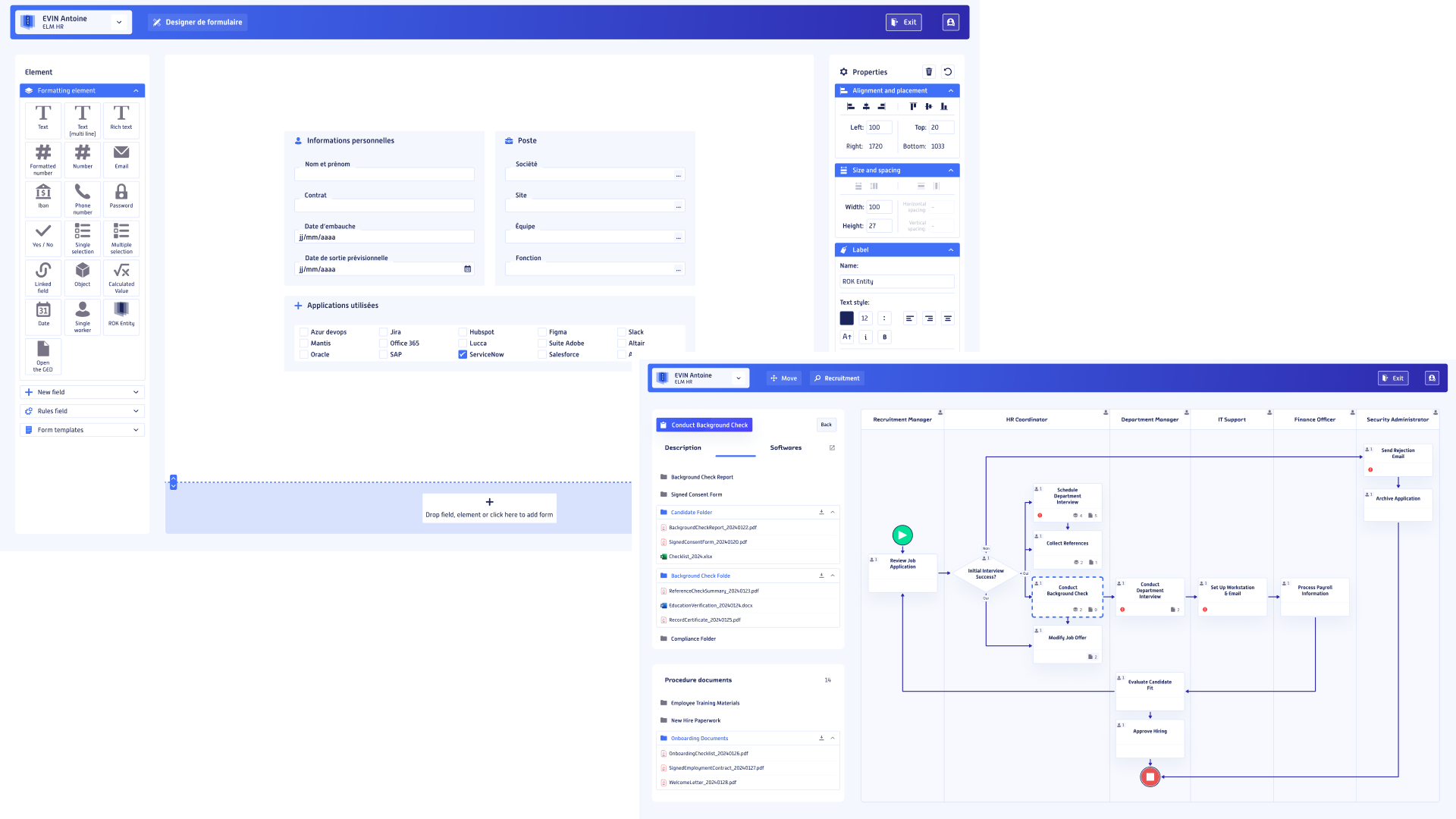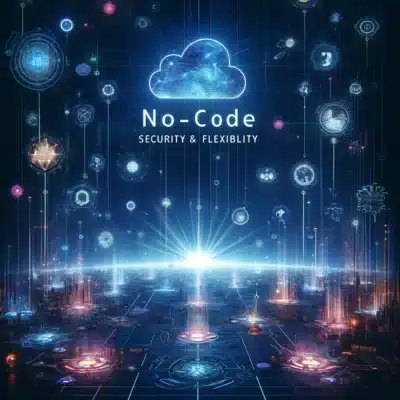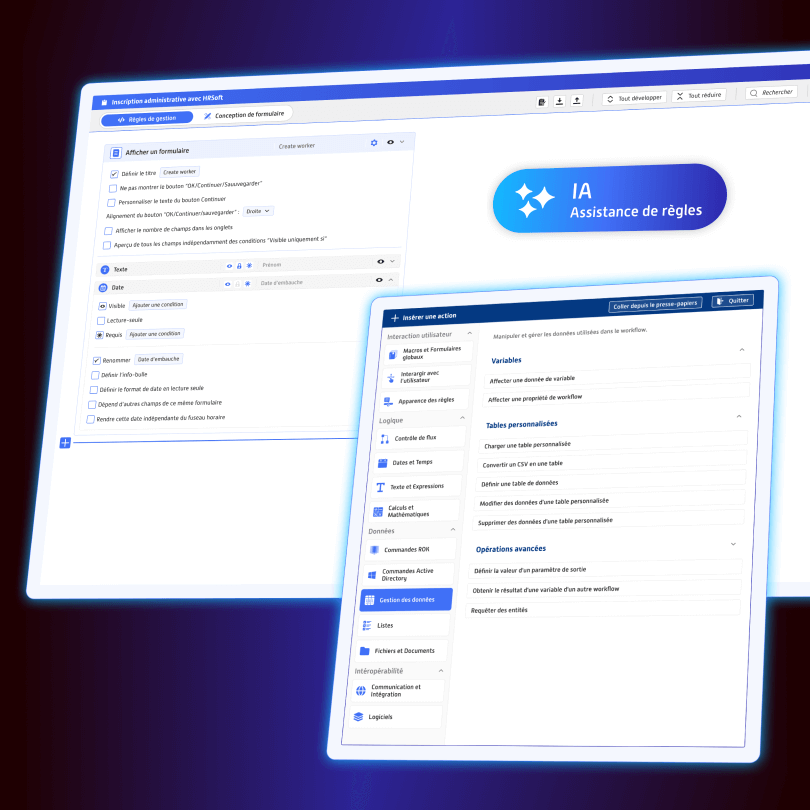The No Code market is rapidly expanding, with an increasing range of offerings and promising prospects. However, this enthusiasm should not overshadow the limitations of these solutions, which mainly include:
-
- The limitation of customization, due to the fact that they offer a predefined set of features and components. This constraint limits creativity and confines the user to less complex applications, a niche where iBPMS solutions excel.
- The complexity of connecting with other applications via APIs, which often requires the intervention of IT teams, even though a library of connectors is available.
- Security and compliance challenges, since the business often creates interconnected applications with the IT system without adequate management of integrity with the HRIS, employee workflows, or the authorization aspect (IAM), not to mention the separation of duties (SoD), thus opening the door to cyber attacks.

“The ROK platform stands out with its remarkable level of customization for form interfaces, offering a limitless design workshop. It makes it easy to design complex apps and bots with No Code | OCR and AI (rok-solution.com). Similar to PowerPoint, it allows for complete customization of the graphical interface and navigation. The provided store enables customization and branding of the created applications to reflect the company or service’s image. Additionally, because its roots are in iBPMS, ROK facilitates the creation of complex business workflows through simple drag-and-drop, fully delivering on the No Code promise to accelerate digital transformation while optimizing the workflows created on a single platform.
For opening applications created with the IT environment, ROK’s modeling interface allows for the integration of third-party APIs without writing a single line of code. The latest version of ROK also includes an AI assistant to facilitate the integration of complex APIs, eliminating the need to spend hours reading their documentation and making the API stores often offered by vendors obsolete.
In terms of security, ROK is defined as ‘compliant & secure by design’. It natively integrates the ability to interface with HRIS systems, IAM tools, and electronic directories such as Active Directory (AD). The platform manages, in real time and transparently for the designer, the mapping of access, including those related to the application created. It links with the company’s organizational charts, clearly exposing the new fields of responsibility of the actors and automatically updates the risk mapping of Separation of Duties (SoD).
Mr. Lounis, CIO of Support Functions France at the Transdev Group (Client Successes: Optimization and Securing of the Supplier Reference (rok-solution.com)), shares his experience using the ROK platform:
“Transdev France uses ROK to manage the lifecycle of its supplier repository, which includes over 40,000 third parties with several hundred requests for creation, modification, deactivation, and reactivation per month. This management is ensured through a secure real-time interface with our ERP and Altares, to guarantee the identity, integrity, and activity status of the third party in the repository. The processes designed in ROK also include Optical Character Recognition (OCR) to dematerialize PDF-format bank account details into a form and facilitate their verification with an interbank control platform.”
Looking ahead, ROK will offer a new modeling interface in June 2024 that will further simplify the creation of No Code applications. Currently, ROK allows the creation of No Code applications from scratch (or from a template in the store) through simple drag-and-drop, but also by importing a Word document or an Excel file describing the desired workflow. The integration of AI will revolutionize application creation by suggesting workflows tailored to expressed needs, accepting desired modifications through natural interaction, and instantly publishing a viable application distributed among various stakeholders, always in compliance with permissions.
In summary, ROK clearly stands out from its competitors with its unique ability to deeply customize developed applications, orchestrate complex business flows leveraging its roots in iBPMS systems, and finely manage permissions as well as overall security, thanks to its integrated HR module and advanced management of organizational charts. It revolutionizes integration with the IT ecosystem by utilizing artificial intelligence to far exceed the capabilities of traditional API stores, which are now rendered obsolete. The next version of ROK promises to reinvent the creation of No Code applications, taking unprecedented advantage of advancements in AI to offer a limitless, deeply intuitive, and fully secure development experience (here, even the established application stores are relegated to the stone age). Thus, ROK does not merely navigate the frontier between No Code and AI but aims to merge the two to establish a new standard in enterprise application creation.
ROK Decoder: Your Questions, Our Answers!
The No Code has never been so clear.
Why use No Code platforms?
No code platforms aim to accelerate digital development by eliminating the need for manual coding and reducing deployment times. They contribute to the democratization of digital creation by empowering business users (citizen developers), thereby fostering innovation and freeing up time for IT teams. Overall, they enable significant cost reductions and offer a consistently positive ROI.
What are the limitations of these solutions?
Although these platforms offer a variety of pre-designed patterns and components, they are limited in terms of presentation possibilities and customization. Similarly, while offering a range of components and connectors, they encounter feasibility issues when deviating from standard applications (complex apps). Additionally, by nature (due to their widespread use) and by design, they open up vulnerabilities to cybercriminals and present security flaws that are difficult to manage.
Customization seems to be a limitation in No Code; what about with ROK?
Beyond providing a range of more or less extensive pattern models that no code solutions offer, ROK features a unique design workshop. Its intuitive drag-and-drop graphical interface and extensive graphic palette facilitate the creation of customized applications in a manner similar to PowerPoint, which offers patterns but also allows you to design a completely original slide from scratch. An ingenious rule engine enables the creation of both unique and multiple forms within the same application, thus opening the door to complex applications when the majority of offerings are limited to single forms.
The range of connectors seems to be limited to the store offered by the provider; what about with ROK?
ROK offers a modeling interface that allows the integration of any web service, including SOAP or REST, in natural language, i.e., without coding. ROK has also integrated AI to accelerate connector creation, assisting the modeler who wants to move faster. With this AI, ROK makes the use of a connector store, which is not always up-to-date and in any case limited, redundant. Finally, for the reluctant computer scientist or those dealing with a proprietary or very complex interface, ROK offers the possibility to code their own connector.
Another cited limitation of No Code is security. Does ROK take this issue seriously?
Indeed, the multitude of apps that can be developed, the ability to interconnect them with sensitive pre-existing company systems, and the fact that the solution is placed in the hands of non-IT users significantly increase the risk of security breaches. In terms of security, ROK is defined as ‘compliant & secure by design.’ It natively integrates the ability to interface with HRIS, IAM tools, and electronic directories like AD. The platform manages access mapping in real-time and transparently for the designer, including those related to the created application. It links with the company’s organizational charts, clearly exposing new areas of responsibility and automatically updating the risk mapping of SoD.
We have internal workflow solutions; what's the difference with no code, and isn't it redundant?
A no code application is designed to allow the creation of applications without writing source code. They aim to democratize app development, making it accessible to non-developers. A workflow software, on the other hand, is designed to automate processes and focuses on modeling, automating, and optimizing business workflows to improve operational efficiency, reduce human errors, and ensure better business process management. The goals are different; the former enables the creation of simple apps without worrying about their integration within the ecosystem or really about the impact in terms of optimizations and performance, while the latter aims at performance and optimization. They are therefore complementary, and sometimes redundant, which is unfortunate, costly overall, and not optimal from a security perspective.
ROK seems to combine No Code and workflow; what about that?
ROK is genetically an iBPMs solution. As such, it aims at organizational performance and business flow automation. Similarly, it allows for the generation of organizational charts, managing computer accesses, handling document management, and risk management. Significant work has been done to make it a fully no-code platform. As a result, in a single solution, you can aim for both the democratization of rapid and innovative applications and contribute to the automation and performance of your organization. This is made possible in a single platform that also guarantees the clarity of roles and responsibilities and the mapping of application rights, ensuring perfect security of what is developed.
There's a lot of talk about AI; what about at ROK?
AI is completely transforming our way of working while also raising real issues of confidentiality, as its learning is through the data it processes… therefore, your data. We have already integrated AI to create connectors (APIs) with third-party applications of your IT system under the modeler’s control. In June ’23, we will offer a brand new way to create applications via AI and a conversational interface, allowing this AI to propose an app through ROK that matches your wish, which you can amend in real
What is the cost of the platform?
The platform can be contracted either OnPremise or as SaaS. The average cost per user for SaaS is less than 5 euros.


